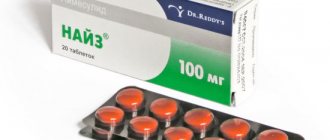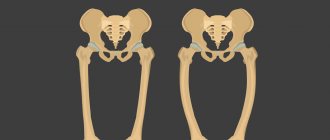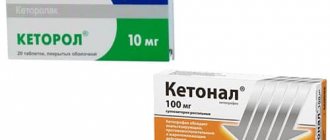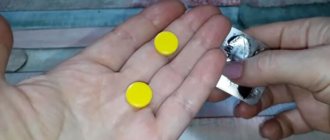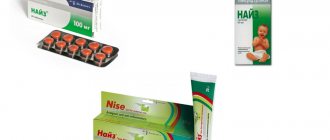The combined drug Novigan quickly eliminates the painful symptoms of algomenorrhea, colic in the stomach and abdominal cavity, and can be used for fever and migraines. The formula of the drug provides improved well-being with cramps, elevated body temperature, and headaches of various origins.
Composition, dosage form
Novigan is available in the form of tablets for oral use: film-coated, packaged in metallized blisters. Each pill contains:
- ibuprofen: 0.4 g;
- fenpiverinium bromide: 0.005 g;
- pitofenone: 0.1 g.
Auxiliary compounds that stabilize the state of the drug and give it shape:
- glycerol;
- talc;
- starch;
- magnesium stearate;
- polysorbate and others.
The secondary cardboard packaging of the medicine contains from 2 to 10 blisters with tablets and detailed instructions included.
The mechanism of action of the drug Novigan
Novigan tablets effectively relieve various types of pain and physical discomfort. The drug is used as an analgesic, antispasmodic and anti-inflammatory. Ibuprofen in its composition provides a blockade of prostaglandins, including those in the peripheral nervous system and tissues of internal organs. At the same time, the substance affects the thermoregulation center, reducing fever and associated discomfort.
Pitophenone hydrochloride is a myotropic antispasmodic that relaxes smooth muscle fibers. Its use helps relieve painful contractions of vascular walls and cavitary organs. Fenpiverinium bromide complements and prolongs its action, having an anticholinergic effect.
The tablet shell quickly dissolves in the stomach cavity, the active substances are absorbed into the blood and distributed in the body fluids, partially binding to plasma proteins. The maximum concentration is usually achieved within 1 hour, and the pharmacological effect develops within 15–20 minutes after administration. The drug is transformed by liver cells, metabolites leave the body along with urine. Residues of the drug remain in tissues and blood for no more than 12 hours.
Novigan has a symptomatic effect, reducing the painful manifestations of pathological conditions. It does not affect the course and causes of chronic diseases.
Nonsteroidal anti-inflammatory drugs for migraine
The main goal of treating a migraine attack is to relieve the headache and associated symptoms. Successful relief of an attack makes the patient adherent to the prescribed treatment and improves his quality of life. Today, to treat a migraine attack, drugs of various pharmacological classes are used, which, to a greater or lesser extent, meet the above requirements [1] (Table 1).
Despite the wide choice of drugs for the treatment of migraine, there is still no complete agreement on their effectiveness. On the one hand, a large number of studies have been accumulated on this problem, and at the same time, only a few of them comply with the requirements of evidence-based medicine (GCP (Good Clinical Practice) standard) and the recommendations of the International Society for the Study of Headache. pain (The International Headache Society, IHS).
International European recommendations call non-steroidal anti-inflammatory drugs (NSAIDs) the drugs of choice for the relief of migraine attacks of mild and moderate intensity. Randomized clinical trials (RCTs) have been conducted on the effectiveness of acetylsalicylic acid [3–6], ibuprofen [7, 8], diclofenac [9–11], metamizole [12], phenazone [13], tolfenamic acid [14], paracetamol [15] . It has been shown that the combination of acetylsalicylic acid with paracetamol and caffeine is highly effective for migraine and has advantages over separately used components [16–18]. Intravenously administered acetylsalicylic acid relieves a migraine attack better than subcutaneously administered ergotamine [19]. The combination of acetylsalicylic acid with metoclopramide was as effective as sumatriptan [20]. Effervescent Aspirin (1000 mg), ibuprofen (400 mg) and sumatriptan (50 mg) were equally effective for migraine two hours after administration [21, 22]. A placebo-controlled study showed that diclofenac potassium in sachet form (50 and 100 mg) was as effective as sumatriptan (100 mg) in relieving migraine [10, 11]. The selective COX type 2 inhibitor valdecoxib (20–40 mg) also reduced migraine pain [23].
The European Federation of Neurological Societies (EFNS) recommends the use of NSAIDs for the treatment of migraine, the effectiveness of which has been proven in randomized, double-blind, placebo-controlled studies [24] (Table 2).
For the relief of migraine, NSAIDs with rapid accumulation in plasma (Tmax) and a short half-life (T1/2) are primarily recommended, which ensures rapid development of analgesia and the safety of the drug with repeated use. In recent years, modified forms of well-known NSAIDs have been created (diclofenac potassium salt (Voltaren Rapid), ibuprofen in the form of L-arginine salt (Faspic) and dexketoprofen trometamol (Dexalgin)) with modified physicochemical, pharmacodynamic and pharmacokinetic parameters to ensure rapid onset analgesia (Table 3).
The effectiveness of NSAIDs for migraine is associated with the suppression of neurogenic inflammation in the meninges. The anti-inflammatory activity of the drugs is realized due to the anti-exudative effect and the reduction of the allogeneic effect of inflammatory mediators. Antiexudative properties cause a reduction in inflammatory edema, which exerts mechanical pressure on tissue pain receptors. The inhibitory effect of these drugs on the production and activity of inflammatory mediators reduces the effect on nerve endings of such biologically active substances as substance P, calcitonin gene-related peptide (CGRP), prostaglandins, bradykinin, histamine, serotonin. It is important to note that inhibition of prostaglandin synthesis reduces the sensitization of pain receptors to the action of other chemical and mechanical stimuli caused by them. A decrease in prostaglandin biosynthesis correlates more with the analgesic effect of NSAIDs than with their anti-inflammatory effect.
In the central nervous system, NSAIDs have an analgesic effect by inhibiting the synthesis of prostaglandins (PGE1-, PGE2- and PGF2-alpha), which are involved in the transmission of pain information. It is believed that a decrease in the level of prostaglandins in the central nervous system causes pain suppression due to increased release of norepinephrine and an increase in its stimulating effect on alpha-adrenergic receptors. It has also been shown that the descending inhibitory serotonergic system is involved in the central analgesic effect of non-narcotic analgesics and NSAIDs and this action is realized, in particular, through serotonin receptors of the spinal cord and the sensory nucleus of the trigeminal nerve. In general, the analgesic activity of many NSAIDs against inflamed tissue is not inferior to the activity of narcotic analgesics [1, 2].
Acetylsalicylic acid has been used to treat pain for over 100 years. Currently used for the treatment of migraine attacks of mild to moderate intensity at a dose of 1000 mg. The maximum plasma concentration is observed after 1–2 hours. Gastrointestinal complaints (dyspepsia, ulcers, bleeding) are class-specific side effects for all NSAIDs, regardless of route of administration. Their frequency and severity depend on the daily dose, duration of use of acetylsalicylic acid and the presence of risk factors. Nausea, vomiting, gastralgia, diarrhea, erosive defects of the gastric and duodenal mucosa, even bleeding, are noted. In children under 12 years of age, taking Aspirin against the background of colds can provoke the occurrence of Reye's syndrome (acute toxic encephalopathy, accompanied by fatty degeneration of internal organs, mainly the liver and brain).
Paracetamol is not inferior to Aspirin in its pain-relieving activity. However, the effectiveness of the drug for migraines is lower than that of acetylsalicylic acid. This is due to the lack of anti-inflammatory action of paracetamol, and aseptic neurogenic inflammation of the dura mater is of key importance in the formation of pain syndrome in migraine. The maximum concentration in plasma is determined after 30–90 minutes. The rate of absorption slows down when ingesting food, antacids, or activated charcoal. The drug is low-toxic and has virtually no ulcerogenic activity. In rare cases, allergic reactions have occurred. With long-term use of high doses, hepatotoxic effects are possible.
Diclofenac (Voltaren) has an analgesic effect superior to many NSAIDs. Rapid and powerful analgesia occurs 15–30 minutes after intramuscular administration of diclofenac sodium salt (75 mg) and 15 minutes after oral administration of diclofenac potassium salt in the form of a sachet (Voltaren Rapid, 50 mg) [10]. A large randomized trial showed that the potassium salt of diclofenac was as effective as sumatriptan in the treatment of many migraine attacks [11] (Table 4). The maximum concentration of the drug in the blood after intramuscular administration of the sodium salt and when taking the potassium salt orally is observed after 20 minutes. With short-term use of Voltaren Rapid, side effects are minor and few [29].
Ibuprofen, naproxen, ketoprofen, ketorolac are well absorbed when taken orally. Among them, ketorolac has the most pronounced analgesia. The maximum concentration in plasma after taking ketorolac is observed after 30–34 minutes, ibuprofen and naproxen after 1–2 hours and 5 hours after taking ketoprofen. NSAID-induced gastroenteropathy occurs more often when using ketorolac, less often when using ibuprofen. With long-term use of ketorolac, the likelihood of liver and/or kidney dysfunction, as well as thrombocytopenia and anemia, increases.
Recently, in order to increase the effectiveness of treatment of a severe migraine attack, it has been proposed to combine NSAIDs and a triptan. It has been convincingly shown that a fixed combination of sumatriptan (50 mg) and naproxen sodium (500 mg) is more effective in relieving a migraine attack than monotherapy with these drugs [25]. Headache at 2 hours was reduced significantly more in patients receiving the fixed combination of sumatriptan and naproxen (65%) than in patients receiving sumatriptan (49%) or naproxen monotherapy (46%) (P < 0.01) (Table 4 ). Complete headache relief in this study was reported in 29% of those taking the fixed combination of sumatriptan and naproxen, 25% of those taking sumatriptan and 17% of those taking naproxen (P < 0.001). Smith TR et al. suggest that the advantage of the combination of a triptan and NSAIDs is due to the complex effect of these drugs on various mechanisms of the pathogenesis of a migraine attack. In 2007, a study was completed that confirmed the high effectiveness of a fixed combination of sumatriptan (85 mg) and naproxen (500 mg) in the treatment of migraine attacks [28]. This paper reports the results of two identically designed studies that show significant benefits of combining a triptan with an NSAID compared with either NSAID alone or placebo (Table 5).
Conclusion
The correct choice of drug for the effective treatment of an attack is a difficult task, the solution of which depends on the severity of the migraine attack, concomitant diseases, and past experience with the use of drugs. Conducted RCTs and our own experience allow us to formulate several provisions that will help increase the effectiveness of treatment of a migraine attack [1]:
- NSAIDs with modified physicochemical properties may be effective for migraine, like triptans.
- The combination of an NSAID and a triptan is more effective than the separate use of an NSAID or a triptan in the treatment of a migraine attack, since they act on different parts of the pathogenesis of the disease.
- If the patient cannot distinguish a migraine attack from a tension headache, then he should take an NSAID.
- If you experience severe nausea and vomiting, you should avoid taking NSAIDs and triptans by mouth. Intranasal, rectal, intravenous or intramuscular routes of administration are preferred.
Literature
- Amelin A.V., Ignatov Yu.D., Skoromets A.A., Sokolov A.Yu. Migraine. Pathogenesis, clinic, pharmacotherapy 2011, 264 p.
- Ignatov Yu. D., Kukes V. G., Mazurov V. I. Clinical pharmacology of non-steroidal anti-inflammatory drugs. M.: GEOTAR, 2010. 258 p.
- Chabriat H., Joire JE, Danchot J., Grippon P., Bousser MG Combined oral lysine acetylsalicylate and metoclopramide in the acute treatment of migraine: a multicentre double-blind placebo-controlled study // Cephalalgia. 1994; 14: 297–300.
- Nebe J., Heier M., Diener HC Low-dose ibuprofen in self-medication of mild to moderate headache: a comparison with acetylsalicylic acid and placebo // Cephalalgia. 1995; 15:531–535.
- Tfelt-Hansen P., Henry P., Mulder LJ, Scheldewaert RG, Schoenen J., Chazot G. The effectivenes of combined oral lysine acetilsalicylate and metoclopramide compared with oral sumatriptan for migraine // Lancet. 1995. Vol. 346. P. 923–926.
- Diener H. C., Bussone G., de Liano H. et al. Placebo controlled comparison of effervescent acetylsalicylic acid, sumatriptan and ibuprofen in the treatment of migraine attacks // Cephalalgia. 2004; 24:947–954.
- Havanka-Kanniainen H. Treatment of acute migraine attack: ibuprofen and placebo compared // Headache. 1989; 29:507–509.
- Kloster R., Nestvold K., Vilming ST A double-blind study of ibuprofen versus placebo in the treatment of acute migraine attacks // Cephalalgia. 1992; 12: 169–171.
- Karachalios GN, Fotiadou A., Chrisikos N., Karabetsos A., Kehagioglou K. Treatment of acute migraine attack with diclofenac sodium: a double-blind study // Headache. 1992; 32:98–100.
- Dahl FC, Bjrkman R. Diclofenac-K (50 and 100 mg) and placebo in the acute treatment of migraine // Cephalalgia. 1993; 13: 117–123.
- The Diclofenac-K/Sumatriptan Migraine Study Group. Acute treatment of migraine attacks: efficacy and safety of a nonsteroidal antiinflammatory drug, diclofenacpotassium, in comparison to oral sumatriptan and placebo // Cephalalgia. 1999; 19: 232–240.
- Tulunay FC, Ergun H., Gulmez SE et al. The efficacy and safety of dipyrone (Novalgin) tablets in the treatment of acute migraine attacks: a double-blind, crossover, randomized, placebo-controlled, multi-center study // Funct Neurol. 2004; 19: 197–202.
- Goebel H., Heinze A., Niederberger U., Witt T., Zumbroich V. Efficacy of phenazone in the treatment of acute migraine attacks: a double-blind, placebo-controlled, randomized study // Cephalalgia. 2004; 24:888–893.
- Myllyla V.V., Havanka H., Herrala L. et al. Tolfenamic acid rapid release versus sumatriptan in the acute treatment of migraine: comparable effect in a double-blind, randomized, controlled, parallel-group study // Headache. 1998; 38:201–207.
- Lipton RB, Baggish JS, Stewart WF, Codispoti JR, Fu M. Efficacy and safety of acetaminophen in the treatment of migraine: results of a randomized, double-blind, placebo-controlled, population-based study // Arch Intern Med. 2000; 160:3486–3492.
- Lipton RB, Stewart WF, Ryan RE, Saper J., Silberstein S., Sheftell F. Efficacy and safety of acetaminophen, aspirin, and caffeine in alleviating migraine headache pain—three double-blind, randomized, placebo-controlled trials. Arch Neurol. 1998; 55: 210–217.
- Diener HC, Pfaffenrath V., Pageler L. The fixed combination of acetylsalicylic acid, paracetamol and caffeine is more effective than single substances and dual combination for the treatment of headache: a multi-centre, randomized, double-blind, single-dose, placebo-controlled parallel group study // Cephalalgia. 2005; 25: 776–787.
- Goldstein J., Silberstein SD, Saper JR, Ryan RE Jr., Lipton RB Acetaminophen, aspirin, and caffeine in combination versus ibuprofen for acute migraine: results from a multicenter, double-blind, randomized, parallelgroup, single-dose, placebo- controlled study // Headache. 2006; 46:444–453.
- Limmroth V., May A., Diener HC Lysine-acetylsalicylic acid in acute migraine attacks // Eur Neurol. 1999; 41:88–93.
- Tfelt-Hansen P., Henry P., Mulder LJ, Scheldewaert RG, Schoenen J., Chazot G. The effectivenes of combined oral lysine acetilsalicylate and metoclopramide compared with oral sumatriptan for migraine // Lancet. 1995. Vol. 346. P. 923–926.
- Diener H. C., Eikermann A., Gessner U. et al. Efficacy of 1000 mg effervescent acetylsalicylic acid and sumatriptan in treating associated migraine symptoms // Eur Neurol. 2004; 52:50–56.
- Lampl C., Voelker M., Diener HC Efficacy and safety of 1000 mg effervescent aspirin: individual patient data meta–analysis of three trials in migraine headache and migraine accompanying symptoms // J Neurol. 2007; 254:705–712.
- Kudrow D., Thomas H. M., Ruoff G. et al. Valdecoxib for treatment of a single, acute, moderate to severe migraine headache // Headache. 2005; 45: 1151–1162.
- Evers S., Fra J., Frese A., Goadsby PJ, Linde M., May A., Sandor PS EFNS guideline on the drug treatment of migraine - revised report of an EFNS task force // European Journal of Neurology. 2009, 16, 968–981.
- Smith TR, Sunshine A, Stark SR et al. Sumatriptan and naproxen sodium for the acute treatment of migraine // Headache. 2005; 45:983–991.
- Krymchantowski AV, Barbosa JS Rizatriptan combined with rofecoxib vs. rizatriptan for the acute treatment of migraine: an open label pilot study // Cephalalgia. 2002; 22: 309–312.
- Krymchantowski AV, Bigal ME Rizatriptan versus rizatriptan plus rofecoxib versus rizatriptan plus tolfenamic acid in the acute treatment of migraine // BMC Neurol. 2004; 4:10.
- Brandes JL, Kudrow D, Stark SR et al. Sumatriptan-naproxen for acute treatment of migraine: a randomized trial // JAMA. 2007; 297:1443–1454
- McNeely W., Goa KL Diclofenac-potassium in migraine: a review // Drugs. 1999, Jun. Vol. 57(6). P. 991-10-03; review.
This article was prepared with the support of.
A. V. Amelin, Doctor of Medical Sciences, Professor
GBOU VPO SPbSMU im. acad. I. P. Pavlova Ministry of Health and Social Development of Russia, St. Petersburg
Contact information about the author for correspondence
Indications for use
It is recommended to take Novigan for any pain syndrome, including those accompanied by spasms or colic:
- for painful menstruation: active components significantly reduce the production of prostaglandins in the female myometrium, relieve pressure in the vessels of the uterus and appendages, help get rid of cramping attacks before the start of the cycle and throughout menstruation;
- with inflammatory processes in the pelvic and abdominal organs: adnexitis, renal colic, pain in the liver, intestines, gall bladder;
- with cystitis;
- for tension headaches caused by poor circulation due to cervical osteochondrosis, for migraines, and meteosensitivity;
- with myositis;
- with neuralgic syndrome;
- for inflammation and degenerative processes in the joints and spine: arthritis, osteoarthrosis, sciatica, lumbodynia;
- for mechanical injuries of joint structures and muscles: bruises, pinching, dislocations, sprains and torn ligaments;
- during the recovery period after surgical interventions.
If necessary, Novigan can be used to relieve toothache. Ibuprofen in its composition reduces the sensitivity of nerves, reducing unpleasant symptoms.
15% of women suffer from endometriosis
Endometriosis occurs when cells from the endometrium (the lining of the uterus) extend beyond the uterine cavity, become attached and begin to grow in other organs. They go through the same monthly cycle as normal endometrial cells, but cannot leave the body as they do during menstruation. This causes inflammation and further formation of scar tissue in the affected areas. And where there is inflammation, there is pain! And, unfortunately, not only pain...
Fact #1
Endometriosis cannot be cured
This sounds harsh, I don’t want to believe it, but today it is true. However, there is good news: the disease can be “curbed”, as a result you can have a good quality of life and avoid infertility, premature menopause, etc.
This is why endometriosis requires long-term treatment, right up to menopause. Even if the disease is incurable, this does not mean that from now on it controls your life. Only a gynecologist can choose the right treatment and develop tactics for managing your condition with endometriosis.
Fact #2
Endometriosis is not easy suffering during menstruation
Endometriosis can significantly affect work ability and overall quality of life, creating problems during the childbearing period, one of which is infertility (more than half of women suffer from this), and can sometimes continue even after menopause.
Fact #3
Pain can occur at any time, not just during menstruation
Pain can occur during urination, defecation, sexual intercourse (depending on the location of the lesions), and sometimes for no apparent reason at all. Sometimes you can predict when your pain will be worse, but endometriosis is usually unpredictable.
Fact #4
Diagnosing endometriosis is not easy
The time from the onset of symptoms to diagnosis can take up to 8 years or more. Women turn to different specialists who make different diagnoses. And often, to relieve pain during menstruation, without a thorough questioning and examination of the patient, painkillers are prescribed, which can mask the symptoms for many years, while the disease progresses.
Fact #5
Endometriosis affects both the physical and mental state of a woman
Pain itself can be the reason for missing work or school, your refusal to engage in social activities, or your avoidance of sexual contacts. Irritability, anxiety, depression, even depression are quite common phenomena in patients with endometriosis.
Fact #6
Endometriosis can affect every woman differently
Even if you find two women with endometriosis in the same places, the likelihood that they will experience the same symptoms is relatively small. Almost all women will experience pain, but its nature and location may differ significantly. Stage I (mild) endometriosis may cause more pain than stage IV (extensive) endometriosis.
Fact No. 7
There is no one-size-fits-all treatment or even combination of treatments that will work for all patients
Treatment is always individualized. For treatment, surgical intervention is used, as well as drug treatment - hormonal drugs and drugs that affect the production of hormones (gonadotropin-releasing hormone agonists)
Fact #8
With endometriosis, the main hormones of femininity - estrogens, work against us
Estrogens normally promote endometrial growth at the beginning of each menstrual cycle. However, with endometriosis, estrogens cause the progression of the disease, because regardless of which organ the cells of the inner lining of the uterus “take root”, they also respond to estrogens, like normal tissue. Therefore, hormonal drugs for the treatment of endometriosis should not contain estrogens.
Fact #9
After childbirth, endometriosis is not cured and may even progress
There is a misconception that pregnancy and childbirth can, if not cure, then at least cause regression of the disease. Alas, this is not true. Endometriosis can progress after childbirth. However, childbirth saves you from something else - it is a powerful prevention of ovarian cancer, the risk of which increases with endometriosis.
Fact #10
You can't stand the pain
Patience and perseverance are inappropriate here. If pain is not stopped in time, it can become chronic: in this case, nerve cells are damaged and perceive pain more acutely. That is, pain sensitivity in general increases: you will feel any pain, even toothache and headache, more acutely than women who do not suffer from endometriosis.
Contraindications
The use of the drug is prohibited for the following health conditions:
- bronchial asthma;
- hypersensitivity to acetylsalicylic acid and other NSAIDs;
- for disorders of blood coagulation and composition, pathologies of the hematopoietic organs;
- for diseases and dystrophy of the optic nerve, glaucoma;
- gastric ulcer, acute colitis, pancreatitis, gastritis, erosive lesions of the gastrointestinal mucosa;
- with a tendency to internal bleeding;
- in the period after heart surgery, with acute cardiac arrhythmias.
Novigan is also not applicable in the early stages of pregnancy - in the first trimester, and in the last month before childbirth. It is contraindicated for nursing women and children under 14 years of age.
The drug is prescribed with caution to the elderly, patients with diabetes mellitus, angina pectoris, hypertension, renal or liver failure.
Dentist consultation during pregnancy
You will need to consult a dentist more than once during pregnancy. It is better to visit the dentist in the first weeks of pregnancy so that, if there are any inflammatory processes in the oral cavity, they can begin timely treatment. It is very important to visit a dentist in the last trimester of pregnancy. At this time, the child’s skeleton and teeth are forming, so right now it is important to carefully monitor the mother’s health.
The teeth of the expectant mother are exposed to some dangers more than those of other patients. During pregnancy, a woman's appetite increases, nausea occurs, and the composition of saliva changes - its acidity increases. All these are favorable factors for the development of bacteria that have a destructive effect on the surface of the teeth.
Choose a clinic based on reviews, don’t go to the first one you come across. It is not so much the proximity to home that is important, but above all the qualifications of the dentist and experience in dental treatment during pregnancy. In our Dentistry clinic on Shchelkovskaya Diamed you will be provided with a full range of services for dental treatment during pregnancy. Don't worry about anything, just make an appointment by calling 8 (495) 033-00-63 or via the Internet by filling out the online appointment form. We are located a 7-minute walk from the Shchelkovskaya metro station at Shchelkovskoye Shosse, building 44, building 5. We work seven days a week.
Side effects
While taking the drug, reactions from the gastrointestinal tract and nervous system are possible:
- loss of appetite, dry mouth, unpleasant taste, nausea, epigastric pain;
- dizziness, insomnia or increased drowsiness;
- decreased urine volume;
- increased sweating;
- visual disturbances;
- increased level of leukocytes in the blood, decreased clotting;
- bronchospasm;
- tachycardia, increased blood pressure.
Possible signs of an allergy to the drug: swelling of the mucous membranes of the eyes and eyelids, lacrimation, urticaria, itching, aphthous stomatitis, vasomotor rhinitis, laryngeal edema. In such cases, immediate discontinuation of the medication is required.
How to use Novigan: instructions
It is recommended to take the drug in short courses: no more than 5 days in a row. The maximum dose of tablets is 3 pieces: 1 three times a day. If well tolerated, Novigan can be taken between meals: 2–3 hours after meals or 1 hour before meals. If you have stomach problems, it is not advisable to take the tablets on an empty stomach. It is safer to take them with food.
Treatment should not be combined with taking tranquilizers, other NSAIDs, drinking alcohol or caffeine-containing products. This may increase side effects and cause intoxication.


